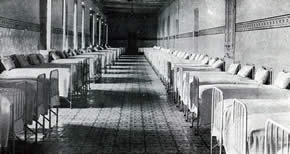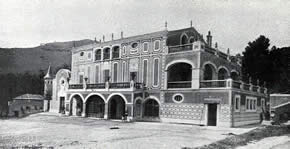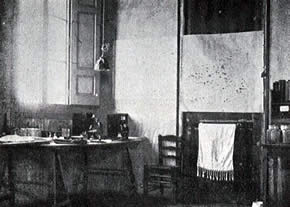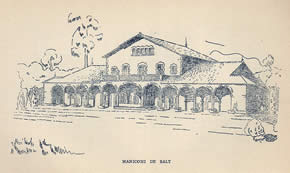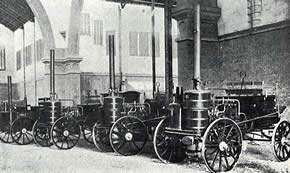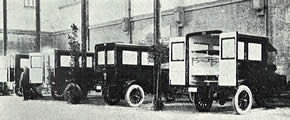A global vision for serving the people
At a time when in Spain there were still diseases that had long been eradicated from other countries in Europe, the Mancomunitat of Catalonia adopted decisive measures to fight them. That is why it undertook tasks to control diseases such as tuberculosis or malaria, started campaigns to inform about ways to avoid their spread, and instructed on how to take care of those affected by them.
Mental health
The Mancomunitat of Catalonia shouldered provincial mental patients services starting on January 1st, 1915, following an agreement by the Assembly eight months earlier.
In contrast with some territorial considerations when facing the costs of treating mental patients, being Catalan was the only condition set by the Mancomunitat before it would commit to taking care of these expenses in whatever mental hospital patients were being housed.
The mental hospital in Salt opened its doors in 1904, although it only treated men, because women were being treated at the Hospital of Santa Caterina and at Sant Boi de Llobregat. On the other hand, the foundation for reinserted mental patients, which depended on the mental hospital in Salt, was in charge of cured or sufficiently functional patients.
Hospitals
By a 1920 transfer agreement, all other charitable services that belonged to the Catalan diputacions became the jurisdiction of the Mancomunitat of Catalonia. The institutions that depended on the Mancomunitat were the shelters, childbirth centers, and orphanages in Barcelona; the childbirth center and the shelter in Girona; the childbirth center, the hospital, and the shelter in Lleida; and the charity house, which was both a childbirth center and a shelter, in Tarragona.
Barcelona
- City Shelter (Casa de Caritat)
It was inaugurated in November 30 1803, and until 1850 all indigents were admitted, but starting on that date, those from outside the province were sent back to their towns. The City Shelter offered its services in several venues around the city. In 1923, health services at the shelter were performed by eight doctors and a pharmacist, they included several nursing homes and and operating rooms.
In its headquarters, several jobs and occupations were held, such as bread making with kneading machine, soup pasta, tailoring, espadrille making, shoemaking, and sawing. From 1838 on, it was in charge of moving the corpses from Barcelona’s old town, and later on this would come to include all the towns annexed to the city.
- Childbirth Center
The first board of members of this charity was constituted in October 1853. From the very beginning, the facilities would house all orphans that until then were admitted at the Santa Creu Hospital, where, due to lack of resources, they could not keep them all.
The Mancomunitat of Catalonia also managed:
School camp of the Casa de Caritat (Can Tarrida)
Epileptics ward (Torre dels Frares)
Recovery center for young children and teenager with tuberculosis (Torre dels Frares)
Catalan Maternity Institution (Les Corts)
Facilities for senior outdoor activities (Casa de Maternitat i Expòsits)
Girona
- Santa Caterina Hospital
It was built in 1666 to substitute the one that was called Santa Caterina New Hospital, founded in 1211 and demolished in 1653. The new building also had a recovery center for the Childbirth Center and a center for mental patients. Its main goal was to assist the sick, whatever their ailment might be. Between 1921 and 1922 this hospital underwent some renovations.
- Maternity Center
The recovery center was located in the Santa Caterina Hospital. Nursing and toddler facilities were located in the building called Hospici. It was a charity established in 1776 and it was divided in three sections: pregnancy shelter, nursing center, and toddler center.
- Casa de Misericòrdia (House of Charity)
It took care of children, ages seven to eighteen, who had no means, and whose families could not take care of their well being, education, and schooling. Indigent people, ages eighteen to sixty, unable to earn a living by keeping a steady job. Seniors and the chronically ill older than sixty who were not fit for any kind of work. The blind, the deaf-mute, and the institutionalized who came from the Maternity House.
Lleida
- Maternity House
Its origins went back to the old Hospital for children and orphans, which was founded supposedly by Sant Vicenç Ferrer in the early 15th century. Later on, it was relocated in a house in Carme Street, built in 1787 with the inheritance left behind by Pòrtolas. It was located in a huge building serviced by the Diputació of Lleida, at the rambla d’Aragó.
- Casa de la Misericòrdia
It was founded in 1836. It was located in a large and clean building transferred to the Diputació of Lleida in 1849. It contained a church, a vegetable garden, rooms, and patios. Children received elementary school education, plus music and art.
When the Mancomunitat of Catalonia took charge of charity foundations, facilities, it stressed education, spending as generously as it was possible on personnel and resources. In November 3, 1921, they started teaching the deaf and mute.
- Hospital
The Santa Maria Hospital in Lleida is, with no doubt, the oldest and most important civil building still in existence. It dates from the mid 15th or early 16th century. It was built in order to bring together several hospitals that existed near Lleida in the mid-15th century.
Tarragona
- Charity Facilities of the Mancomunitat
Its mission was to provide shelter for orphans born at the Childbirth Center and those from the outside. It also provided shelter for orphans born in the province, and also those children whose parents could not take care of them due to extreme poverty.
After it was transferred to the Mancomunitat, special measures were taken so that children with a particular aptitude for some kind of job would be sent to Barcelona’s Charity House.
- Casa de la Misericòrdia
It housed orphaned children under 10 who requested it. In some special cases, it also admitted children, no older than ten, whose parents suffered extreme poverty, or were physically not fit for work.
Health Services
Once health services were transferred to the Mancomunitat, it created a Health Commission composed of deputies and representatives from the main medical establishments. It was chaired by the president of the Mancomunitat, who would define the future tasks of Health Services, at the same time offering some counsel and keeping an eye on their activities.
On July 28, 1921, a royal decree ordered the creation of associations that would set forth operations of the provincial Health Brigades. The Mancomunitat, at the request of all towns in Catalonia, requested to be exempt from this duty, considering that they were well on track to satisfy all health service requirements. Another royal decree on January 19, 1922 granted this.
It consisted of mobile facilities spread over four city centers: Lleida, Barcelona, Reus, and Figueres.
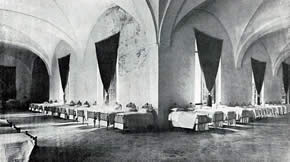
House of Charity in Girona – Girls’ bedroom
House of Charity in Lleida – a bedroom
Charity House – epileptics ward (Horta)
Childbirth Center – Catalan Maternity Institution (Les Corts).
Malaria care facilities at El Prat de Llobregat – a lab.
Asylum in Salt.
Health services – water treatment units
Health brigades – automobiles used to transport sick people and medical instruments.
Photographs from the book L’obra realitzada: anys 1914-1923 / Mancomunitat de Catalunya (Works completed: Years 1914-23 / Mancomunitat of Catalonia)
Author: Mancomunitat of Catalunya.
Year of publication: 1923.








